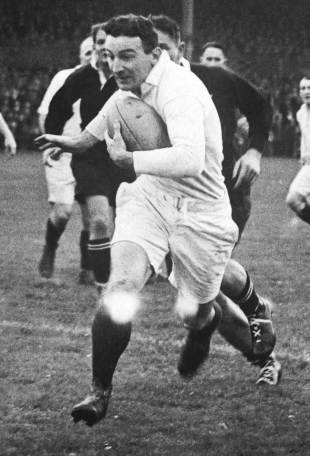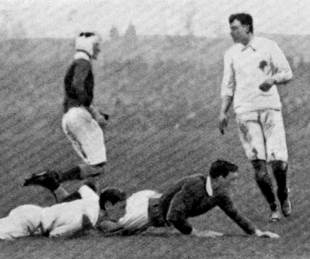|
Ask John
Lithuanian rugby and Alec Timms
John Griffiths
October 10, 2012

Haydn Tanner played both for and against the British & Irish Lions
© PA Photos
Enlarge
Welcome to the latest edition of Ask John where renowned rugby historian John Griffiths will answer any rugby-related query you have! So, if there's something you've always wanted to know about the game we love but didn't know who to ask, or you think you can stump our expert - then get involved by sending us a question. In this edition, John looks at winning Test runs, individuals who have played for and against the British & Irish Lions, Alec Timms, the Lions' match against Ceylon in 1950 and books on rugby history. How close are New Zealand to establishing a new Test winning-run record ? Ken, New Zealand The Fred Allen-coached Kiwi team won 17 Tests in a row from 1965 to 1969, the best winning run among the Tier One nations. They were then beaten by the Springboks in the opening Test of the 1970 series. Gary Teichmann's Springboks equalled the All Blacks' record in 1997 and 1998 before losing 13-7 to England at Twickenham in their last autumn international of the year. The world's international record, however, is held by Lithuania who won 18 games in a row going up through the lower European divisions between 2006 and 2010 - beating the likes of Hungary, Norway, Bulgaria, Holland, Serbia, Armenia, Israel and Andorra. After the 1986 battle of Nantes, the All Blacks went 23 Tests from the start of the 1987 RWC to 1990 unbeaten at Test level, the best-ever unbeaten Test run. David Kirk handed over the captaincy to Wayne Shelford in 1988. Their copybook was blotted by a 19-all draw with Australia in Brisbane in 1988. They were finally beaten by the Wallabies (21-9) in Wellington in 1990, one year before the Aussies triumphed at RWC 1991. Last Saturday's Rugby Championship Grand Slam win against South Africa was New Zealand's 16th in a row since losing to Australia in Brisbane in the final game of last year's Tri-Nations. They play Australia in an additional Bledisloe Cup Test in late October and then travel to Europe for the autumn Tests. If they remain unbeaten they'll take Lithuania's Test record by winning their 19th in a row in their second autumn Test - against Italy in Rome on November 17. How many players have played both for and against the Lions, and what fixtures were they involved in? Paul Johns, New Zealand Further to the post-war players and matches mentioned in the original reply (posted September 12) three more instances have come to light. On April 1,1939, Sam Walker's 1938 touring side to South Africa reconvened to play an unofficial Lions match against their manager, B C "Jock" Hartley's XV at Ravenhill in Belfast. The two sides were as follows: Sam Walker's 1938 Lions XV: V G J Jenkins; B E Nicholson, H R McKibbin, D J Macrae, R Leyland; G E Cromey, G J Morgan; C R A Graves, W H Travers, G T Dancer, R B Mayne, R Alexander, S Walker (captain), P L Duff, W G Howard Major B C "Jock" Hartley's XV: R R Davey; M J Daly, W M Glenn, J C Merlin, F J V Ford; J D Torrens, H Tanner; T B Dunn, T A Groves, M R Neely, P M O'Connell, D B O'Loughlin, S R Couchman, I Williams, J W S Irwin (captain). The "Lions" won 39-12 scoring nine tries to two. The three 1938 tourists who played against their former fellow Lions this day were scrum-half Haydn Tanner and Stan Couchman and Ivor Williams in the manager's back-row. Have you any details relating to the early life of Alec Timms, an Australian who studied medicine in Scotland, played for his adopted country and went on the British/Irish Lions visit to his native country in 1899? Peter Scott, Scotland Alexander Boswell Timms was born at Mount Hesse near Inverleigh, west of Geelong (Victoria, Australia) on March 2 1872. He was the fourth child (of nine) of William Timms who owned the 30,000-acres Mount Hesse Station, Victoria's leading wool exporters. Timms junior, nicknamed "Shako" but usually known as Alec or Alick, entered Geelong College in 1882. A severe drought forced his family to sell their commercial interests soon after, and in 1883 Alec boarded at Melbourne Grammar School. He returned to Geelong the following year and earned fame there as a scholar and sportsman before finally leaving in 1892, having captained the school at Cricket and (Aussie Rules) football. He also played Aussie Rules for the Geelong club.

Alec Timms (central) loses the ball after going over against England
© PA Photos
Enlarge
Both his parents were born in Victoria but married in 1866 in Fife in Scotland, his paternal grandmother's home. Alec Timms went back to the family's roots to study medicine in Edinburgh in 1893, played rugby for the University and Edinburgh Wanderers and won his first Scotland cap in their threequarter line against Wales in 1896. A noted all-round athlete he also held the Scottish Hurdles Championship title in 1896 and 1897. He returned to Australia as part of Rev Matthew Mullineux's 1899 British/Irish touring team and was a fixture in the side's Test threequarter line, playing in the three winning matches of that series. After the tour he became a regular in the Scottish side, winning the last of his 14 caps in 1905 as captain of the team that won the Calcutta Cup. During a distinguished international career he featured in two Triple Crown sides. He was ever-present in the 1901 Scottish side that carried all before them, and at Richmond two years later kicked the dropped goal that proved to be the difference between the sides when Scotland beat England 10-6 to seal another Championship and Triple Crown season. Timms was renowned for the length of his drop-kicking, the legacy of his successful career as an Aussie Rules footballer. In the Welsh match of 1903 he landed a penalty with a sweetly-struck drop-kick and his four-pointer to secure the Calcutta Cup and Triple Crown at Richmond was met with "great applause from the Scotch supporters, who were present in large numbers" according to the Glasgow Herald. After completing his medical studies at the Edinburgh College of Surgeons in 1903, Timms was in general practice in South Wales before the Great War and turned out 17 times for the Cardiff club between 1903 and 1905. Later he was a GP in Redhill, Surrey and passed away in a London nursing home on May 5 1922, aged 50. Fundraising for a memorial stained glass window to Timms for installation in St John's Church, Redhill, in Surrey began soon after his death. His youngest brother, Charles Timms, also studied at Edinburgh University and was a Lion in South Africa in 1910. What were the teams in the Lions' match against Ceylon on the 1950 tour? Richard Finch, England The Lions beat All-Ceylon 44-6 on September 18, 1950 on their return from a tour of New Zealand and Australia. The teams were: All-Ceylon: M C Bostock; S Navaratnam, N W Dewing, J E L Burton, C D Heath; R E Thomson, F A C Roelopsz; H H Campbell, M Shannon, R Whalley, D Cartridge, B B Richards, L M Mollison, D Scobie, L Ephraums British & Irish Lions: B L Jones; M F Lane, N J Henderson, B L Williams, R Macdonald; J W Kyle, W R Willis; T Clifford, D M Davies, J D Robins, J R G Stephens, J E Nelson, J S McCarthy, E R John, V G Roberts. Referee: Mr C A Cameron. Howard Campbell, the Ceylon prop, was a Cambridge Blue and former Scotland internationalist who played four Tests in 1948 and 1949. I am very interested in all of Rugby History, especially how it evolved and changed. Can you tell me of a few good books to look at? Grant Stinson, Australia The "bible" for rugby historians is Rev Frank Marshall's Football: The Rugby Union Game which was first published by Cassell in 1892. A second edition appeared in 1894 and a revised volume came out in 1925. It provides a detailed description of the handling game's origins, the various forms of football played at the English and Scottish Public Schools in the early 19th century and the progress of rugby union at international, tour, county and club level in the second half of the Victorian age. There are also excellent volumes setting out the early development of the game in New Zealand (Arthur Swan's first volume of the History of New Zealand Rugby - 1948) and South Africa (Ivor Difford's History of South African Rugby Football -1933). In more recent times the best historical work on the game was John Reason and Carwyn James's collaboration, The World of Rugby, published by the BBC in 1979 to accompany their television series outlining the game's history and shown in the early months of that year. All of these books are available from the leading suppliers of rugby memorabilia in the UK. © ESPN Sports Media Ltd.
|
Live Sports
Communication error please reload the page.
-
Football
-
Cricket
-
Rugby
-
- Days
- Hrs
- Mins
- Secs
F1 - Abu Dhabi GP
Abu Dhabi Grand Prix December 11-131. Max Verstappen ()
2. Valtteri Bottas (Mercedes)
3. Lewis Hamilton (Mercedes)
4. Alexander Albon ()
5. Lando Norris ()
6. Carlos Sainz Jr ()
-
ESPNOtherLive >>
Golf - Houston Open
Snooker - China Open
Tennis - Miami Open

